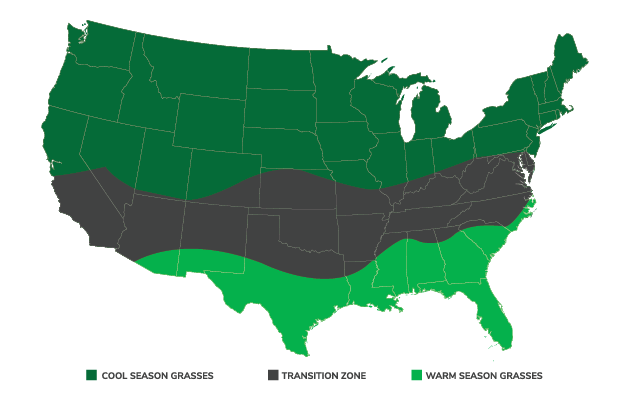Spring is swiftly approaching. This is our favorite time of year, with warmer temperatures meaning more time outside—but there may be some work to do on your lawn before it is ready to enjoy this spring.
After the brisk winter, your lawn may not be looking its finest. Whether it was covered in a blanket of snow for months or had simply gone dormant from the cooler temperatures, you will need to breathe new life back into your turf and get it ready for a fun spring season.
Read on for some tips on how to refresh your outdoor living space and keep it looking great until next winter.
A word about grasses

The following checklist gives advice on two timelines: one for cool-season grasses and one for warm-season grasses. However, it’s important to keep in mind that there are three zones for US lawns: North, South and Transition. The transition is a zone where both warm and cool season grass coexist, requiring a more detailed and prescriptive approach – especially if you have multiple grass types growing in your lawn.
States that typically grow cool-season grasses
Illinois, Indiana, Kansas, Missouri, North Carolina, Ohio, Connecticut, Delaware, Idaho, Iowa, Massachusetts, Maryland, Maine, Michigan, Minnesota, Montana, Nebraska, New Hampshire, New Jersey, New York, North Dakota, Oregon, Pennsylvania, Rhode Island, South Dakota, Utah, Vermont, Washington, Wisconsin, Wyoming
States that may grow both warm- and cool-season grasses
Tennessee, North Carolina, Oklahoma, Kentucky, Virginia, West Virginia, Arkansas
States that typically grow warm-season grasses
South Carolina, Georgia, Alabama, Mississippi, Louisiana, Florida, California, Arizona, New Mexico, Texas
Disclaimer: Even within these zones, weather varies from state to state and year to year, which will influence your specific lawn care timeline. The dates mentioned below should be considered guidelines rather than deadlines.
Now, before the weather gets too hot, here’s your spring lawn maintenance checklist:
1. Dust off the trusty lawnmower
After a long sleep in your shed, your lawnmower is ready to help you bring your lawn back to life. But first make sure you give it a little love so it’s working at its best. Be sure to clean or replace the air filter, change the oil, sharpen the blade, and check the spark plug.
When to do it:
- Cool-season zone: Sometime in March, which is the perfect time to both beat the spring rush at the store and ensure your fresh oil and gas aren’t sitting idle in the machine for too long.
- Warm-season and transition zones: Late February, so it’s ready for use in March.
2. Clear out the debris
As temperatures climb and the birds begin chirping, you may find that your lawn is covered in fallen leaves, sticks, twigs and other debris from winter. If you don’t remove this layer of debris, your lawn could get smothered and develop unsightly patches since your lawn and its roots would be prevented from accessing the air, water and nutrients needed to thrive. Clearing this debris also allows any TruGreen services to be more effective since they aren’t blocked by the layer of debris.
When to do it:
- Cool-season zone: The moment the snow melts.
- Warm-season and transition zones: In February before your lawn becomes active again.
3. Tackle weeds before they tackle your lawn
No one wants a lawn taken over by weeds. That’s why we offer pre-emergent treatments, which will help you fend off annual weeds before they start growing. It is important to start your lawn care at the right time and under the correct agronomic conditions to help prevent the weeds from germinating. Once the temperatures start rising, consult with your TruGreen specialist on when to start your treatments.
4. Time to rev the mower
Remember that lawnmower you gave some TLC to earlier this year? Well it’s time to use it! The first season cut removes dead blades of grass from the past season, helping to wake up the lawn. Once the grass begins growing, make sure to mow it at the correct height and be sure you don’t cut more than a third of the grass’ height during any single mowing. Most grass types should be kept at least three inches tall as longer, thicker turf helps combat weeds and conserve water in the soil.
When to do it:
- Cool-season zone: Directly after cleaning up the debris on the lawn, which is usually sometime in March-April. Make sure to wait until all the snow has melted.
- Warm-season and transition zones: When grass begins growing again, which is usually around March.

5. Feed your plants
During the cold and sometimes frosty winter season, lawns stay in a hibernating state to stay alive. After a winter’s rest, they start to wake up with an appetite. Give it a little boost of nutrients in the spring with an initial dose of fertilizer. TruGreen will partner with you to ensure that this treatment occurs at the best time and in the right amount to bring out the best in your lawn, trees and shrubs.
6. Post-emergents are your friend
Despite your best pre-emergent efforts early on in the spring, those annoying weeds can still pop up in your yard. When this happens, a TruGreen specialist can assess your weed problem and tailor a post-emergent solution just for you.
When to do it:
- Cool-season zone: Starting in May, if needed.
- Warm-season and transition zones: Starting as soon as February, if needed.
7. Don’t forget to water
Last but definitely not least, every lawn will require a healthy amount of high-quality H2O. While a portion of this will come from natural rainfall, during the drier months you’ll probably need to supplement with your garden hose or sprinkler system. Aim for about one inch of water per week. An easy way to measure an inch of water is to spread a few empty tuna cans across your lawn as you water. When they’re full, that’s an inch.
When to do it:
- Cool-season zone: Start in June, if rainfall is less than one inch per week.
- Warm-season and transition zones: Start as early as March.
And there you have it! Your springtime lawn maintenance checklist, putting you on the right track to get your lawn lush, healthy and green for the season.
If you have any questions or concerns about maintaining a healthy lawn this spring, the experts at TruGreen are always available to help. Our specialists will develop a lawn care plan specifically tailored to your lawn’s unique needs. And with the TruGreen Guarantee, you can be confident you’ll have a lawn you’ll love.
For more information about TruGreen’s range of lawn care services, call 866.688.6722 or visit TruGreen.com.













